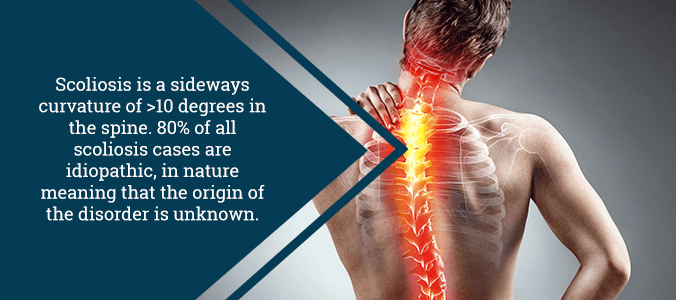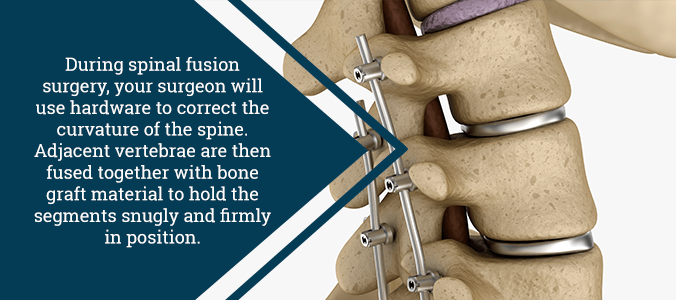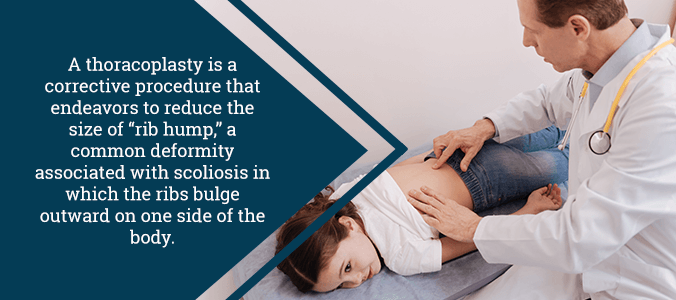The Basic Types of Scoliosis Surgery
Under normal circumstances and from a frontal view, the spine runs straight down the middle of the body. With scoliosis, however, this is not quite the case. In fact, a pronounced sideways curvature develops in the spine. The angle of this curve may be quite small, rather large, or lie somewhere in between. To be clinically diagnosed with scoliosis, the curve must deviate by more than 10 degrees from “normal.” Moreover, the curve may appear to take on either a “C” or an “S” shape depending upon the nature of the case.
Not all cases of scoliosis require surgery. But, for some patients, intervention is absolutely necessary to halt progression and reverse pain. Your doctor will be able to tell you whether or not scoliosis surgery is right for you. In some cases, more than one surgical procedure may be needed to achieve the best possible outcome. Your surgeon will consider all of the factors of your case and present you with the pros and cons of each viable procedure. This, in turn, will allow you to make an educated decision regarding which procedure you ultimately choose.

What Causes Scoliosis?
80% of all scoliosis cases are idiopathic, meaning that the cause for the condition is unknown. While this may be the case, there are certainly cases in which the cause of the condition is discernible. Usually, doctors classify these cases in one of two ways: as nonstructural or structural.
In nonstructural scoliosis, the spine works as it should, though it still takes on a curved appearance. There are a plethora of reasons why this may be. For example, the patient may have one leg longer than the other; he or she may have had severe muscle spasms; or he or she may have appendicitis. In these rare cases, when the underlying condition is treated, scoliosis resolves itself.
With structural scoliosis, however, the curvature of the spine is rigid and your doctor will not be able to reverse the issue as easily. Structural scoliosis generally occurs because of conditions such as Marfan syndrome, cerebral palsy, muscular dystrophy, and more. Generally, this version of scoliosis is congenital—meaning that it arises from some kind of issue during childbirth. Your doctor may be able to detect this condition soon after birth, or it may not develop fully until adolescence.
Typically, scoliosis rears its head during growth spurts between the ages of 10 and 15. The diagnostic rate of minor idiopathic scoliosis is roughly the same for both genders. But, the condition is 10 times more likely to reach the “severe” designation in girls.
Scoliosis Procedures
The rest of this reading is devoted to the most commonly practiced surgeries for treating cases of scoliosis. Again, sometimes multiple procedures may be necessary depending upon your case. Be sure to communicate with your doctor thoroughly so that you can make the most informed decision about your care.
Spinal Fusion Surgery
Many spinal deformities require some variation of spinal fusion surgery for treatment. Fusion describes a process whereby the vertebrae are welded together via the use of bone grafts. Normally, this welding process takes three months to completely heal. During the recovery period, your doctor will evaluate the fusion progression through x-ray imaging.
Bone graft material has a number of potential sources such as the ribs, spine, or even the pelvis. Typically, using a local bone from the spine is less painful to the patient than harvesting the bone from another area of the body. In some instances, your doctor may use protein bone graft substitutes instead. Usually, this is the case when the patient has the added ailment of a previous pseudoarthrosis (i.e. failed fusion) or osteoporosis.
It is important to note that all patients should quit smoking in the months before their scheduled surgery date. Smoking drastically slows down the healing process and thereby reduces the chance of a successful fusion. Once your doctor has performed your surgery, you should still continue with smoking cessation. Smoking simply makes everything worse when it comes to bone healing and orthopedic health.

Osteotomy
An osteotomy refers to a procedure in which the affected bones are cut and thereafter removed. Your doctor will perform this procedure through either an anterior or posterior approach.
For treating scoliotic curves, your doctor will use an osteotomy to correct your spinal deformity. Typically, doctors use this procedure to treat adults with rigid scoliotic curves, flatback, children with large curves, or in cases in which realignment is necessary following a previous spinal fusion.
Video-Assisted Thoracoscopic Surgery (VATS)
This technique only really applies to patients with a thoracic curvature of the spine. For a VATS procedure, your doctor will need to temporarily deflate one of your lungs. Because of this, not all patients with thoracic scoliotic curves are viable candidates for VATS; lung deflation is too risky for certain patients. Additionally, certain curves will make access to the spine via VATS too difficult to be worth doing. It all depends on the specific individual as well as the nature and elements of their case. Of course, these are not the only reasons why VATS isn’t a feasible option for some patients. To learn if you qualify for VATS, you must discuss the specifics of your case with your doctor.
During VATS, your doctor will make small incisions called portals in the side of your chest. Next, the surgeon will utilize cameras, scopes, and video monitoring devices to help guide him or her through the procedure. All of these devices will help make the whole ordeal much less invasive while simultaneously providing equal or better outcomes.
After the procedure, the small incisions made during the surgery will be hidden by the patient’s arm. The scars left by VATS are also much smaller, paving the way for less scarring and a quicker recovery period.
Thoracoplasty
Scoliosis patients usually have a prominent rib hump. Naturally, this deformity is yet another target for corrective scoliosis procedures.
A thoracoplasty is a corrective surgical procedure whose goal is to reduce the size of the rib hump. Usually, this procedure involves the partial removal of as many as five ribs. Typically, this procedure is performed in conjunction with other scoliosis corrective surgeries, but it may be performed as a separate procedure on a completely different date. In some cases, your doctor will need to install a chest tube that will stay in for a day or two after the procedure is complete.
This procedure is not as common today, as current advances in spinal instrumentation have led to an improved rotational correction of the deformity.

Hemivertebrae Excision
Hemivertebrae are wedge-shaped vertebral bodies. Under normal circumstances, vertebrae are rectangular in shape. This spinal deformity usually forms before birth and often results in kyphosis or scoliosis as the patient grows.
If the patient’s condition is progressive and the patient exhibits a lack of balance, the hemivertebra should be surgically removed. Your doctor will perform this procedure using an anterior-posterior approach, or in some cases, just a posterior approach. Your doctor will most likely implant rods and screws for this procedure, and more often than not, the patient will need to wear a brace for several months after the surgery.
Contact Us
Do you have scoliosis? Have conservative treatments failed to provide you with the relief that you so desperately desire? If so, then please consider contacting our practice at (855) 220-5966. Dr. Jason E. Lowenstein is a leading expert in the field of scoliosis corrective care. Dr. Lowenstein and his team of highly trained staff will work tirelessly to ensure that you are put on a treatment plan that suits the specific needs of your case. Contact us today to receive the highest industry standard in scoliosis care!
